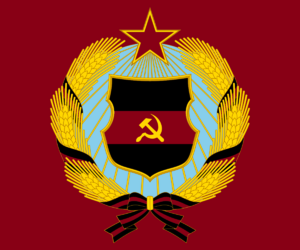Kolodorian People's Defense Forces
| Kolodorian People's Defense Forces | |
|---|---|
 | |
| Founded | 2 October 1954 |
| Service branches | Kolodorian Ground Forces Kolodorian Air Forces Kolodorian Naval Forces |
| Headquarters | Salhar |
| Personnel | |
| Conscription | Partial |
| Active personnel | 650,000 (2019) |
| Industry | |
| Foreign suppliers | |
| Related articles | |
| History | Vinyan War Vyzhvan-Kolodorian War Cherniyan War 2019 Invasion of Vyzhva |
The Kolodorian People's Defense Forces is the military of Kolodoria. Founded in 1954, the KPDF consists of a Ground Force, Air Force, and Navy. The Commander-in-Chief of the KPDF is the President of the Council of Ministers, the de facto head of state within Kolodoria.
History
In accordance with Directive No. 7, the Kolodorian People's Defense Forces was officially established on 2 October 1954 with General Secretary Aleksis Kraulis as it's commander-in-chief, and Marshal Darius Gukauskas as the head of the Chief of the General Staff. Many of of the KPDF's personnel were composed of former soldiers of the Royal Confederate Army. Although many members of the Kolodorian Communist Party wanted to completely purge the armed forces of any officers of the former RCA, Kraulis, himself a veteran of the Northern War, did not agree. Although a number of senior officers were forcibly removed or refused the opportunity to serve in the KPDF, a large portion of the RCA's General Staff were retained, serving as a core nexus of leadership for the KPDF in it's early years.
Although originally planned to be a territorial defense force not to exceed a quarter of a million men, by 1960 Kraulis's nationalist ambitions had ballooned the KPDF to over 500,000 personnel and 25 divisions. In 1975 the KPDF carried out the invasion of Tír Tairngire, starting the Vinyan War. During this time the KPDF was heavily supplied by Polvokia and Letnia, receiving thousands of tons of military hardware, equipment, and supplies. Kolodoria's success (after a five year long conflict) convinced Kraulis of the viability of Kolodoria as an independent power.
In 1986 Kolodoria embarked on another territorial conquest during the Vyzhvan-Kolodorian War, which saw modest gains. A decade later the KPDF would invade Cherniya, sparking the Cherniyan War and once again pitting the Socialist Republic against Letnia. The four year long bloodbath ended with a Kolodorian defeat and the death of Kraulis, throwing Kolodoria into political chaos. After a series of economic reforms allowed Kolodorian growth in GDP and government revenue to reach the KPDF, vastly needed modernization efforts began in early 2008. They KPDF were a major force in the 2019 Invasion of Vyzhva.
Doctrine
To the Kolodorians, war is a manifestation of the class struggle. It is an expression of the conflict between the "progressive forces of socialism" and the "reactionary forces of imperialistic capitalism," which they feel will ultimately be resolved in favor of socialism. The Kolodorian concept of war represents a continuation of politics. In many foreign perceptions, war occurs when politics fail to resolve conflicts nonviolently. The Kolodorians feel that war is the least desirable method by which the forces of history will move toward complete victory for socialism. The Kolodorian political and military theorists compared the socialist and capitalist camps by a concept called the "correlation of forces." This concept compares the relative political, moral, economic, and military strengths of both sides. In the Kolodorian view, the correlation of forces has been shifting in favor of the socialist camp since the Kolodorian Revolution in 1954. Kolodorian communist ideology requires the correlation to shift continuously in factor of socialism. This correlation of forces may be advanced by both violent and nonviolent means. When it is advanced by violent means, the military component of the correlation is the dominant factor.
Kolodorian military doctrine is the officially accepted set of concepts that delineate the ways and means to achieve military objectives in the interest of politics. This doctrine also specifies the structure of the Kolodorian People's Defense Forces, allocates industrial resources and output, and orients research and development efforts to support the armed forces. Military doctrine is the blueprint drawn up by the highest Kolodorian political leaders that describes in specific detail the shape of the armed forces and the way they are to be used. The formulation of Kolodorian military doctrine is a continuous evolutionary process based on communist ideology, Kolodorian foreign policy, economic and military strengths of adversaries, Kolodorian resources and geography, history, science and technology. Kolodorian military doctrine is based on an elaborate, integrated system of thought. The doctrinal concepts are precisely defined, and each has its place in a hierarchy of importance that corresponds to its military-decision making level. The system deals with all military issues, ranging from national defense policy down to platoon tactics. Kolodorian military officers are quite familiar with the entire system of thought and routinely express themselves in these terms. They think and formulate decisions using these concepts to accomplish any variety of military and non-military related tasks.